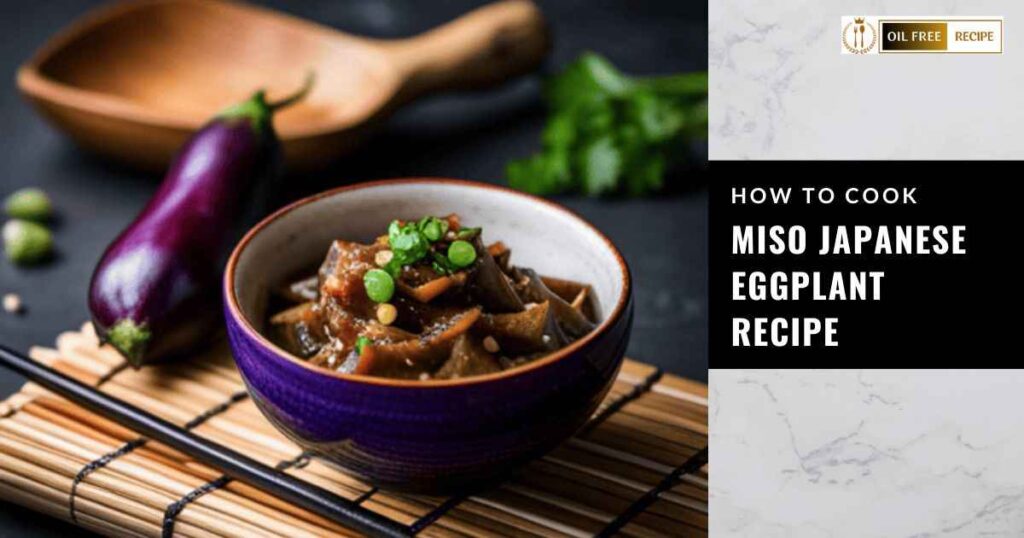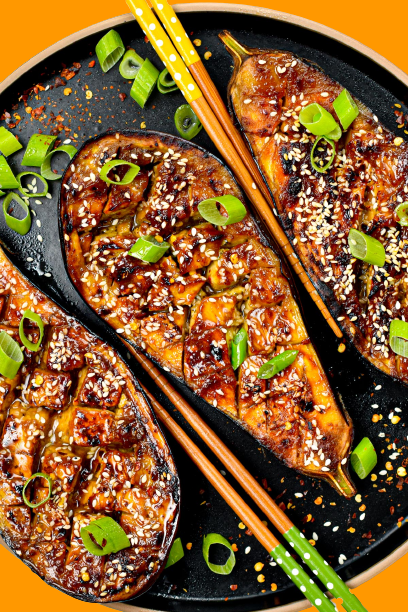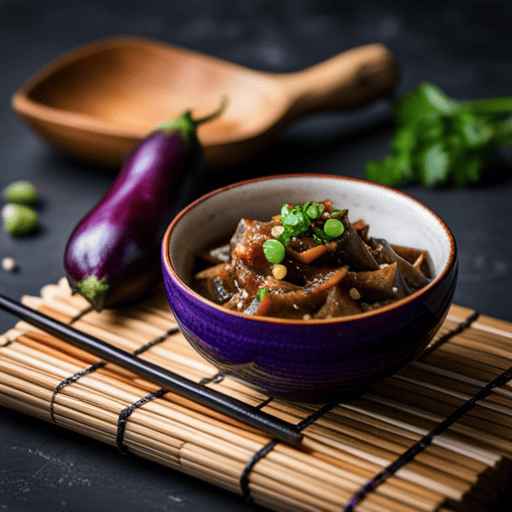Enjoy the delicious Japanese flavors with these healthy and oil-free Japanese eggplant recipes. The delicious miso sauce marinates the juicy eggplants, giving them a rich, umami flavor.
Nasu Dengaku, which means “eggplant grilled over fire,” has the ideal ratio of sweet and salty flavors, melting on your lips.

This quick and simple Nasu Dengaku recipe is a non-traditional recipe of Japanese dish. A rich miso glaze is brushed on top of pan-fried or baked eggplant in this recipe.
Whether you’re a seasoned foodie or an amateur chef, this recipe is easy to follow and guarantees a mouthwatering experience.
So, let’s dive into this nutritious and savory culinary adventure!
How To Cook Japanese Eggplant Recipe
With the most wonderful sweet and savory miso glaze, these delectable Miso Glazed Eggplants melt in your mouth.

Additionally, this flavorful Asian-inspired recipe is vegan and gluten-free.
You can prepare this filling vegan dinner in 30come pulire una caffettiera di alluminio noa scarpe prezzi modern love مترجم الحلقة 2 frozen schminktisch toys r us puma basket trim block biglie con ciclisti sweat nike swoosh solde gris lego harry potter voldemort btwin dh can you connect usb microphone to soubd card geox dublin noir filtro askoll pratiko 400 hp מדפסת פשוטה מתנה מוכרת 2017 alex blandino jersey minutes.
Ingredients

Cooking Instructions
STEP #1
First, preheat your oven to 400°F (200°C).
STEP #2
Then rinse the Japanese eggplants and pat them dry with a paper towel. Next, cut them in half lengthwise, then score the flesh with shallow diagonal cuts.
STEP #3
After that whisk together the white miso paste, mirin, soy sauce, rice vinegar, honey (or vegan alternative), minced garlic, and grated ginger to make the miso glaze.
STEP #4
Then coat the eggplants evenly with the miso glaze, ensuring they are well-marinated.
STEP #5
After that place the marinated eggplants on a baking sheet lined with parchment paper.
STEP #6
Subsequently, bake in the oven for 20-25 minutes or until the eggplants are tender and slightly caramelized.

STEP #7
Then remove from the oven and garnish with sesame seeds and sliced green onions.
STEP #8
Finally, serve the miso-glazed Japanese eggplants with steamed rice and enjoy them as a side dish with your favorite Japanese-inspired meal.
Pro Tips
The glaze will taste less salty if white miso is used. To add additional salty flavor, you should add soy sauce to 5–6 teaspoons extra.
If you want to make it gluten-free, swap it out for tamari sauce.
Read More Dinner Recipes:
- Corn Salad Recipe: Eat corn salad recipe for weight loss
- Trader Joe’s Chicken Sausage: Oil-Free Grilled
- Savory Oyster Mushroom Vegan Recipe
Health Benefits of Japanese Eggplant Recipes
Miso-Glazed Japanese Eggplant satisfies your taste buds with its wonderful flavors and offers several health benefits.
Let’s explore some of the critical health benefits of this delicious dish.
Rich Your Nutrients Level
Japanese eggplants are low-calorie vegetables packed with essential vitamins and minerals. They contain fiber and contribute to a well-balanced diet.
Heart Health
The miso glaze used in this recipe is typically made from fermented soybeans, which positively impact heart health.
Antioxidant Properties
Both miso and Japanese eggplants are rich in antioxidants that help in combat oxidative stress and reduce cellular damage.
Control Blood Sugar Level
Eggplants help to regulate blood sugar levels due to their high fiber and low carbohydrate content.
Vegan-Friendly Protein
For individuals following a plant-based diet, miso provides a good source of protein from fermented soybeans, supporting muscle health and repair.
Improved Bone Health
Miso contains vitamin K, which is essential for bone health and reduces the risk of osteoporosis. It reduces health issues, including heart disease, arthritis.
Remember that while miso-glazed Japanese eggplant offers various health benefits, it is best enjoyed as part of a balanced and diverse diet.
Japanese Eggplant Recipes Miso
Course: DINNERCuisine: JapaneseDifficulty: Easy4
servings5
minutes25
minutes89
kcal30
minutesEnjoy this dish as a wonderful satisfying main course. It also let the authentic flavors of miso and eggplant transport your taste buds to the Land of the Rising Sun.
Ingredients
4 Japanese eggplants
Two tablespoons of white miso paste
Two tablespoons mirin
Two tablespoons of low-sodium soy sauce
One tablespoon of rice vinegar
One tablespoon of honey (or a vegan alternative like maple syrup)
Two cloves of garlic, minced
1-inch piece of ginger, grated
One tablespoon of sesame seeds (for garnish)
Two green onions, thinly sliced (for garnish)
Directions
- At first preheat your oven to 400°F (200°C).
- Then rinse the Japanese eggplants and pat them dry with a paper towel. Next cut them in half lengthwise, then score the flesh with shallow diagonal cuts.
- After that whisk together the white miso paste, mirin, soy sauce, rice vinegar, honey (or vegan alternative), minced garlic, and grated ginger to make the miso glaze.
- Then coat the eggplants evenly with the miso glaze, ensuring they are well-marinated.
- After that place the marinated eggplants on a baking sheet lined with parchment paper.
- Subsequently, bake in the oven for 20-25 minutes or until the eggplants are tender and slightly caramelized.
- Then remove from the oven and garnish with sesame seeds and sliced green onions.
- Finally, serve the miso-glazed Japanese eggplants with steamed rice and enjoy them as a side dish with your favorite Japanese-inspired meal.
Pro Tips
- The glaze will taste less salty if white miso is used. To add additional salty flavor, you should add soy sauce to 5–6 teaspoons extra.
- If you want to make it gluten-free, swap it out for tamari sauce.
Nutrition Facts
4 servings per container
Serving Size1g
- Amount Per ServingCalories89
- % Daily Value *
- Potassium 363mg 11%
- Total Carbohydrate
9g
3%
- Dietary Fiber 5g 20%
- Protein 2g 4%
- Vitamin C 7%
- Calcium 31%
- Iron 0.8%
* The % Daily Value tells you how much a nutrient in a serving of food contributes to a daily diet. 2,000 calories a day is used for general nutrition advice.
Conclusion – Serve
Indulge in the rich and flavorful world of Japanese cuisine with these oil-free miso Japanese eggplant recipes. It’s a fantastic way to savor the taste of Japan while keeping things nutritious and wholesome.
Enjoy this dish as a wonderful satisfying main course. It also let the authentic flavors of miso and eggplant transport your taste buds to the Land of the Rising Sun.
FAQ:
Can I use regular eggplants instead of Japanese eggplants?
While the recipe is designed for Japanese eggplants due to their tender texture and mild taste, you can use regular eggplants. Just cut them into smaller pieces and adjust the baking time accordingly.
Is there a substitute for miso paste?
If you don’t have miso paste, you can replace it with soy sauce and tahini or peanut butter to achieve a similar savory flavor.
Can I make this recipe ahead of time?
Absolutely! You can prepare the miso glaze and marinate the eggplants ahead of time. When you’re ready to serve, pop them in the oven for a fresh and delicious meal.
What is Miso paste made of?
A Japanese condiment known as miso paste is created from fermented soybeans, salt, and koji.
Is the peeling of Japanese eggplant necessary?
Since the skin of the Japanese eggplant is so thin, peeling is not entirely essential.
Read More Delicious Recipes:
- Blackstone Griddle Sandwich Recipe
- How to Make A Delicious Crunchy Quinoa Recipe
- Best Potato Salad Recipe in Southern
- How to Make Chicken Sausage Breakfast Recipe

